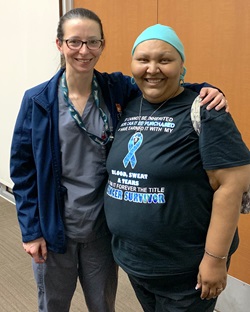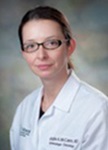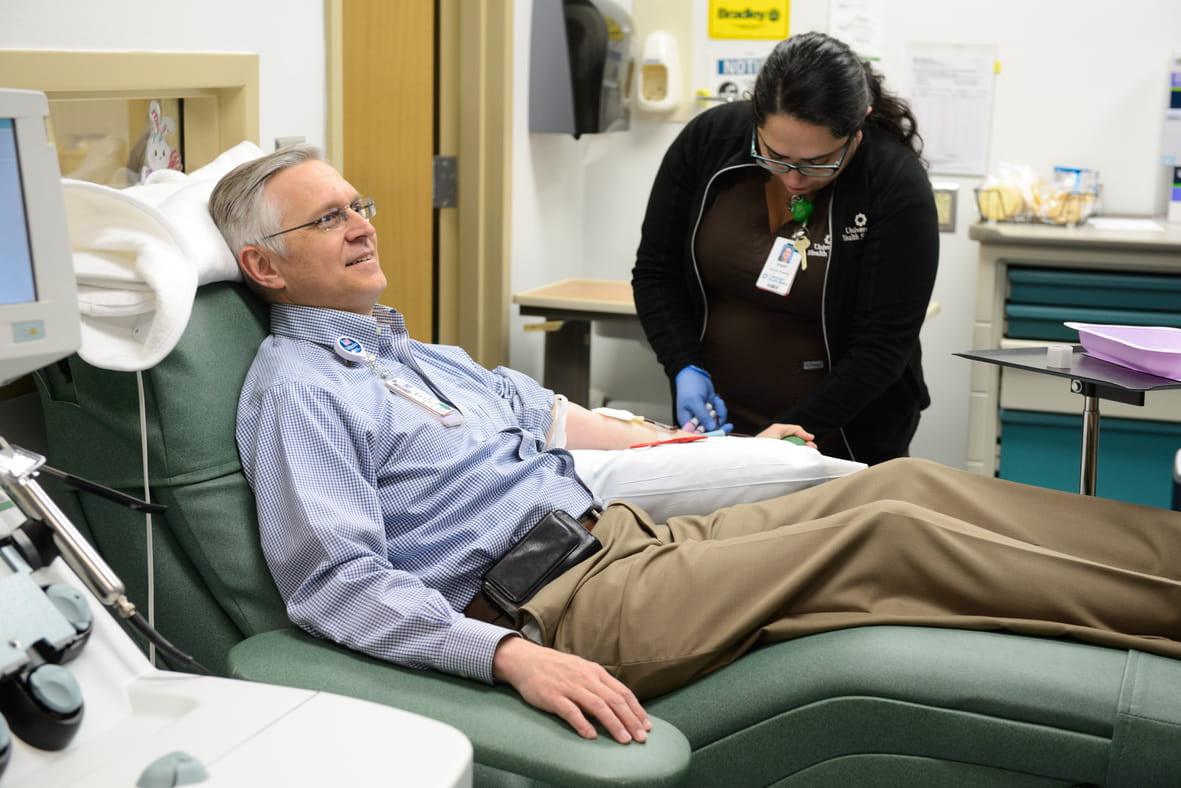When Yvonne Serrano learned she had uterine cancer, it had already spread to her ovaries and nearby lymph nodes. She was in Stage 3C uterine and ovarian cancer, moving toward Stage 4.
Serrano had been battling symptoms and searching for answers for months before her February 2019 diagnosis. Plagued by nearly constant menstrual bleeding, an extremely heavy flow and golf-ball-size blood clots, Serrano had known something wasn’t right since the previous October. She had lost weight, even though she wasn’t trying to, and she felt exhausted all the time.
“I had no appetite, frequent urination and pain and numbness on one side,” said Serrano, who works in the pediatrics unit at University Health’s Robert B. Green campus. “After work, I would crawl into a fetal position because it was so painful.”
Serrano went to her primary care physician for help. She was diagnosed with diabetes, but that didn’t explain her symptoms. Over the next four months, she had blood tests, two pap smears, two transvaginal ultrasounds and three biopsies—all inconclusive. Her doctor said the next step was a dilation and curettage (D&C) procedure to remove tissue from her uterus for testing.
She was referred to another doctor for the D&C, and soon afterward, she received her cancer diagnosis. A few days later, Serrano had an appointment with Dr. Georgia McCann, a gynecologic oncologist at University Health.
“It’s a day I won’t forget,” Serrano said. “Dr. McCann was firm but compassionate, and she said it was probably best to do a radical hysterectomy with oophorectomy because the cancer might have spread.” This type of uterine and ovarian cancer surgery involves taking out the uterus, cervix, both ovaries, both fallopian tubes and some nearby tissue to increase the probability that all the cancer is removed.
“She asked if I had planned to have children. I said that I did, but I’d rather be around for my family,” said Serrano, who has two adopted sons.
She agreed to undergo the surgery. It was now February—she had lost 42 pounds since October when she first went to her primary care doctor.
Uterine and ovarian cancer surgery
Under Dr. McCann’s care, Serrano had four rounds of chemotherapy before her surgery to shrink the tumors and prevent the cancer from continuing to spread. The radical hysterectomy with oophorectomy was expected to take about four and a half hours, but in Serrano’s case, it took more than eight hours.
“Dr. McCann went strand by strand of my lymph nodes to get as much of the cancer as she possibly could,” Serrano said. Three weeks after the July surgery, she had three more rounds of chemo to treat any remaining cancer.
Dr. McCann said Serrano was fortunate that she had an excellent response to chemo before surgery, allowing her to have a minimally invasive robotic procedure called a laparoscopy. The incisions were small, and Serrano had a quick recovery time along with lower risks of complications. She spent only one night at University Hospital.
Serrano’s surgical experience is the exception rather than the rule for ovarian cancer patients, Dr. McCann said. In many cases of ovarian cancer, women don’t have any symptoms in the early stages of the disease, which gives the cancer time to spread. Uterine cancer, like Serrano had, typically shows symptoms in earlier stages, prompting medical evaluation sooner. Serrano’s symptoms allowed her doctors to diagnose the disease before it spread to organs outside the pelvic region.
When ovarian cancer is widespread, surgery isn’t so simple. Many women must have an exploratory laparotomy in which the surgeon makes a large incision in the lower abdomen. During this invasive surgery, the doctor—typically a gynecological oncologist—can see where cancer has spread and can remove tumors or other cancerous tissue. The patient will spend up to five days in the hospital, and it may take up to six weeks for a full recovery from surgery.
Because Serrano’s surgery was less invasive, she experienced very little pain and she was back on her feet the next day.
“The goal is to get patients back to their normal activities as soon as possible,” Dr. McCann said. “We don’t recommend bedrest and definitely want them up the first day after surgery. They can take the stairs, but they should not lift anything heavier than 10 pounds and should avoid rigorous activity for about a week. We usually say no driving for two weeks.”
Dr. McCann said women can resume their regular diet, as much as they can tolerate, shortly after surgery. They should also drink plenty of water as they recover.
Life after surgery
After Serrano’s last round of chemo in August, she followed up with Dr. McCann in September to discuss what to do next. That’s when Dr. McCann delivered the good news—Serrano is cancer free.
“She said my CT scan came back normal and I was good to go,” Serrano said. “There was nothing to do next; I didn’t need maintenance. My mom and my youngest son were with me. It took some time to process.”
Serrano has been cancer-free for a year. She still follows up with McCann every few months but doesn’t have any active therapy.
While that September day was a joyful one, Serrano still has some longstanding effects from the surgery and the chemotherapy. One common side effect of the chemotherapy drugs used to treat gynecological cancers is peripheral neuropathy—pain in the hands and feet, which can sometimes be debilitating. Many women can’t hold a cup of coffee, tie shoes or manage buttons.
And after a radical hysterectomy with oophorectomy, women begin experiencing symptoms of menopause—hot flashes, irritability, depression, fatigue. These symptoms may get better over time, but usually don’t go away completely. McCann said low-dose antidepressants are the first line of treatment to manage menopause symptoms, but hormonal treatment may be appropriate for some women.
Serrano still deals with neuropathy, but it’s not as bad as it used to be. Some days are harder than others. She said she sometimes experiences chemo brain—she’ll forget what she’s saying or can’t express her thoughts well. She might walk into a room and completely forget why she’s there, and she said she stutters frequently now. Her bones ache some days—“sometimes it feels like arthritis to the max”—but other days she’s completely fine.
“The real struggle is trying to feel normal again,” Serrano said. “During chemo, you’re just fighting and not thinking. Afterward, the emotions catch up with you. It has been an emotional rollercoaster ride, but you learn to appreciate everything that comes your way much differently than you would have before.”
To manage her emotions, Serrano joined the Purple Heals Gynecologic Cancer Group, a support group McCann created to help women navigate their fight against cancer. The group members also participate in the National Ovarian Cancer Coalition’s annual Together in Teal run/walk every September.
Serrano said the Purple Heals group changed her life—“it’s a different type of bond”—and she still attends meetings to support the other women. Not every cancer story ends as happily as hers did, and she wants to be there to help bear the burden of anger and bitterness that some women experience.
“Yvonne has always been positive and optimistic and upbeat,” Dr. McCann said. “It’s important to have a good support system and to reach out to people who have undergone similar treatment to help with the feeling of being alone. Yvonne is fortunate because she has a strong family support system. But even though their family may love these patients dearly, they can’t truly empathize. It’s good to have people who truly understand, and Yvonne shares her positive attitude.”
Serrano said that over the seven months she was in University Health’s care, Dr. McCann became not only her doctor, but also her friend.
“She cares for you from the heart; you’re more than just a patient to her,” said Serrano, who praised all of the doctors, nurses and staff who tended to her along the way. “I met the most wonderful, caring and compassionate people from the Women’s Clinic to the Radiology Department to the Infusion Clinic, which has some of the most amazing nurses who oversee your needs and manage every aspect of care for your diagnosis.”
A Survivor’s Advice
Serrano offers some words of wisdom to women who face a diagnosis of uterine, ovarian, cervical or other gynecologic cancer. She urges all women to trust their intuition and to seek a second opinion if they’re not satisfied with the answers they first receive.
She also offers encouragement to women who are just beginning their fight against cancer.
“Never give up,” Serrano said. “As hard as the struggle and the emotional ride are going to be while you’re going through it, it leads you to being stronger than you ever thought you were. When I saw the light at the end of the tunnel, I was stronger than I ever was.”
University Health gynecology experts specialize in the diagnosis and treatment of numerous conditions affecting the female reproductive system, from routine gynecologic care to advanced treatments for cancer.






